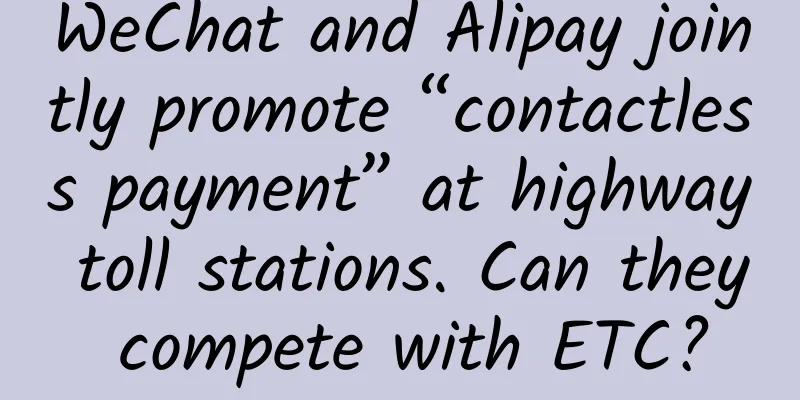WeChat and Alipay jointly promote “contactless payment” at highway toll stations. Can they compete with ETC?

|
After seeing the news that WeChat and Alipay simultaneously launched the "contactless payment" service at highway toll booths, the reporter asked friends A, B, and C to share their views. As expected, all of them gave positive comments. A is a novice female driver who just bought her first car a few months ago. She used the word "salvation" to describe the significance of "contactless payment" to her. A is petite and has average driving skills. When she passes through a toll station to get a card, she often struggles because she can't figure out the parking position. "I have to unbuckle my seat belt and lean half of my body out to reach the card machine, which is very embarrassing." B works in Shenzhen. He has to go back to his hometown hundreds of kilometers away to visit his parents during holidays. Every time he goes home, he feels helpless about the long queues in front of the toll booths. "The holidays are short, and I have to be stuck in the toll booths for so long every time. It feels so bad." C recalled an experience in which he was stopped at a highway toll booth late at night because he forgot to bring cash. "It was around 2 a.m., and there were few cars. I stopped more than a dozen cars before I got cash from a kind driver." The application of mobile payment technology at highway toll stations has made them "breathe a sigh of relief and feel a lot more relaxed." Pilot projects in multiple locations In fact, before WeChat and Alipay both launched the "contactless payment" at highway toll stations, mobile payment had been available for a long time in the form of "scan code to pay" at highway toll stations. When passing through a toll station, car owners need to show their Alipay/WeChat QR codes, and the toll window staff or self-service scanners will scan the car owner's QR code to pay the fee. "Scan code to pay" is currently the most widely used mode of mobile payment in highway scenarios. Taking Alipay as an example, it has been implemented in highways throughout Hubei and Shandong, as well as some highways in provinces such as Hunan and Zhejiang. The widely acclaimed "contactless payment" adopts the form of "license plate payment", which requires binding the Alipay/WeChat account with the license plate in advance. When the vehicle passes through the toll station, the camera recognizes the license plate number and automatically deducts the fee from the corresponding account. Alipay users with a credit score of 550 or above can search for "High-speed Zongheng" in Alipay, find the "License Plate Payment" function, bind their Alipay account to the license plate number, and use the "License Plate Payment" function. However, Alipay has only piloted the "License Plate Payment" model on highways in Henan and Shandong provinces. Corresponding to Alipay, WeChat Pay has launched the "High-speed e-travel" function. Users can search for the "High-speed e-travel" WeChat public account or applet and follow the instructions to enter relevant information to bind the license plate. According to Leifeng.com, since November 23, 2017, Shandong Province has opened 215 "High-speed e-travel" experience toll stations. It is worth noting that the "license plate payment" function of Alipay and WeChat is currently in the pilot stage. The full launch of the system requires the unified implementation of all toll stations in the province, so at present, whether it is "scan code payment" or "license plate payment", car owners need to stop at the entrance of the highway to pick up the card and stop at the exit to return the card. Therefore, many car owners said after their experience that "ETC is more convenient, after all, there is no need to stop to take out or return the card." Liu Xiaojie, general manager of Ant Financial's Urban Services Division, also admitted that at this stage "mobile payment is a useful supplement to the electronic toll collection (ETC) on highways... It mainly provides convenience for car owners who do not often use highways and are worried about forgetting to bring change." Although the "contactless payment" based on license plate recognition by Alipay and WeChat is still in the pilot stage, it has given us a glimpse of the future of "fast passage without stopping, without taking cards", and Alipay and WeChat have described this beautiful vision to us more than once. So, how far are we from realizing this vision? Is the existing technology mature enough? Is the technology mature? The concept of "contactless payment" is not new. Last year, Alipay and Jieshun Technology launched the "contactless payment" parking lot at Shanghai Pudong Airport, allowing this concept to be quickly implemented in the field of transportation. According to official data from Alipay, the total daily traffic at Shanghai Hongqiao Airport's T1 and T2 terminals is close to 30,000 times. After the introduction of "contactless payment" technology, the time it takes for each car to leave has been reduced from 10 seconds to less than 2 seconds, and the overall efficiency of the parking lot has increased several times. According to Leiphone.com (Official Account: Leiphone.com), Jieshun Technology's Jie Parking "contactless payment" has been opened in more than 500 parking lots in South China, and plans to open 8,000-10,000 new parking lots by the end of the year. This shows that the contactless payment technology in the parking environment is already relatively mature. Compared with parking lots, highway toll stations are complicated in two main ways: first, vehicles pass through faster; second, vehicles are prone to following each other during congestion (there are ground sensors at the entrance of the passage. If the vehicle behind follows too closely, the ground sensors will detect the presence of a vehicle and the barrier will not fall), which affects payment settlement. Yan Jun, senior product manager of Jieshun Technology, said that the current license plate recognition accuracy of the "contactless payment" parking lot is over 99% when the vehicle speed is around 20 kilometers per hour. With reference to the ETC speed standard of 20 kilometers per hour, it is not difficult to transplant "contactless payment" to high-speed toll stations. Of course, any business behavior must consider the input-output ratio. It is understood that the construction cost of a single lane of a "contactless payment" parking lot can be compressed to a low level. Compared with parking lots, the entrances and exits of toll stations are more standardized, and there are no sharp turns or steep slopes. In the view of Ren Peng, CEO of Zhenshi Technology, "contactless payment" at highway toll stations is even simpler than parking lots. It is not difficult to infer that cost will not be an obstacle to the large-scale application of "contactless payment" at highway toll stations. In addition, Yan Jun also introduced that most parking lots that have already opened QR code payment can open "contactless payment" only through background upgrades without updating hardware, provided that the parking lot management agrees. This may mean that all toll stations on highways in Hubei and Shandong that have opened Alipay QR code payment can quickly upgrade to "contactless payment". The real challenge facing the "contactless payment" technology may be how to prevent the use of fake license plates, duplicate license plates, and car-following to evade fees. At present, there are some coping methods in the industry, such as combining feature recognition technology such as license plates, vehicle models, body colors, and interior ornaments, and the accuracy rate has reached a relatively high level. Of course, as the effect improves, the cost will also increase accordingly. As Dr. Sheng Gang, director of the Intelligent Institute of the Highway Research Institute of the Ministry of Transport, said, "contactless payment" no longer has a purely technical bottleneck. The key is how to balance input and output. At present, the proportion of "contactless payment" parking lots in China is still relatively small, mainly because a complete ecosystem has not been formed. The data between various manufacturers cannot be interoperable, and car owners cannot get a continuous and complete experience. This problem also exists at highway toll stations. Currently, WeChat and Alipay are conducting pilots in different regions, but it is not difficult to judge that as the scale expands, both parties will inevitably find a way to integrate and coexist. Competing with ETC for market share? The high-sounding concept of "contactless payment" often makes people forget that its essence is still non-stop payment. In fact, non-stop payment with the help of ETC system has existed for many years. So, under the premise of ETC, is it necessary to spend a lot of effort to promote "contactless payment" based on license plate recognition and mobile payment? Dr. Sheng Gang believes that this depends on the needs of car owners, because the purpose of any payment method is to give car owners a better experience. According to the pilot situation in some provinces, the number of transaction records using mobile payment has reached 2-3 million per month, which proves that consumers do have such needs. However, whether "contactless payment" can be promoted on a large scale still depends on its ultimate user experience and cost-effectiveness. Although ETC is very convenient and has been developed for many years, its penetration rate is only about 38%. The reason is that its user experience still needs a lot of improvement, such as single function, cumbersome application process, troublesome invoicing, and the risk of fraudulent use of "black technology". This gives "contactless payment" a lot of room for development. The advantages of "contactless payment" based on mobile payment technology are that it is very open, closely integrated with social applications, and simple to operate, but how to connect it with the existing highway system is a huge mountain that stands in its way. Dr. Sheng Gang believes that at this stage, "contactless payment" cannot compete with the large-scale and mature ETC, but as the latter continues to develop, competition between the two is inevitable. ETC is currently constantly improving its user experience, but because of its large scale and the impact of one move on the whole body, it needs to move step by step. The lightly equipped "contactless payment" has developed rapidly, but it will certainly be under pressure and encounter many problems as its scale expands. For example, in the future, if non-stop payment is to be realized, a credit system must be introduced. How to introduce most users whose credit scores do not meet the requirements into the system and form a large enough scale is the next issue that companies need to think about. In addition, being able to enjoy a large enough discount is also a key factor in determining whether "contactless payment" can compete with ETC. Self-build, cooperation or commission? The highway toll collection system is a huge project. Assuming that "contactless payment" is used on a large scale in the future, what kind of construction and operation model should be adopted? Dr. Sheng Gang shared his insights with Leiphone.com. Dr. Sheng Gang introduced that there are three possible construction and operation modes of "contactless payment" in the future - self-construction, cooperation and entrustment, each of which has its own advantages and disadvantages.
Dr. Sheng Gang believes that, on the whole, each region may eventually choose different models based on its own actual conditions, forming a situation where multiple models coexist. Conclusion The pilot of "contactless payment" in highway scenarios has just begun, and there are still many areas that need to be improved in terms of experience. Regardless of whether "contactless payment" can be widely used like ETC in the future, or even surpass ETC, it provides consumers with more choices and plays a positive role in promoting the update and optimization of ETC. What we need to do next is to keep looking forward to it. |
<<: Selection of App diversion solutions under H5 mainstream browsers
>>: How to correctly implement line spacing and line height in iOS
Recommend
A comprehensive B-side design guide: tree selection
Long time no see. In the next few weeks, I will u...
"Listening" and "singing" are two different things. Good pitch does not mean good singing!
Singing is one of the main ways for modern people...
Argument on the hot search! Skipping breakfast VS skipping dinner, which one has a greater impact on the body?
In the fast-paced modern life, many people often ...
Video account operation plan, growth strategy, and traffic monetization strategy (Part 1)
Editor’s note: With WeChat Video Account’s full-l...
B150 motherboard is coming, will it be the next most popular motherboard?
In August this year, Intel launched the sixth-gen...
How to make money with WeChat red envelopes (I’ll give you the specific method)
It is no longer a secret that making money with W...
NDRC: Strategic emerging industries will be increased and China Export-Import Bank will provide no less than 800 billion yuan in financing
The National Development and Reform Commission re...
iPhone 7 data is inexplicably lost. Why is Apple's frequent problems caused by this?
Apple has been having a hard time recently. The i...
Lin Xiaojun won the gold medal! What can short track speed skating bring us?
Review expert: Wang Jinying, associate professor ...
Do you think Fuling only has pickled mustard tubers? Learn more about this bright new star in the energy industry~
Image from Sinopec Author: Huang Xianghong Duan Y...
Another feature of Android 13 has been discovered: a virtual machine can be used to run the ARM version of Windows 11
According to android authority, with the release ...
Why haven't you recovered after getting Yang Kang? Which literature on the study of COVID-19 is reliable?
Recovery takes time, and taking too much rest can...
How much does it cost to customize a large turntable mini program in Jinzhou?
There are two types of customization of Jinzhou B...
In-depth analysis of activity operations: post-launch operation plan
First look at this picture: I divided the operati...
Data Report | Is automotive industry promotion ineffective? See how peers invest...
During the period of 2011-2017, the scale of Chin...









